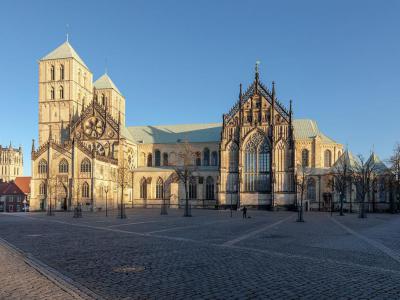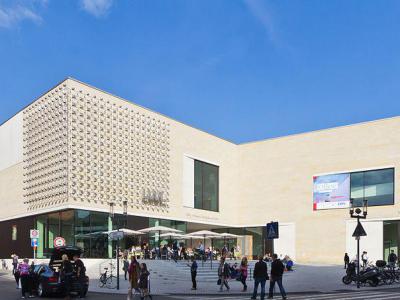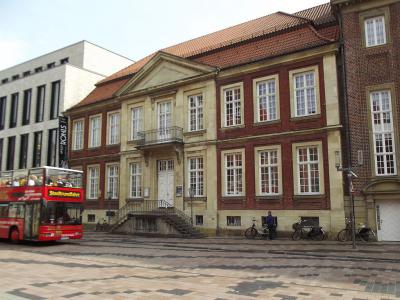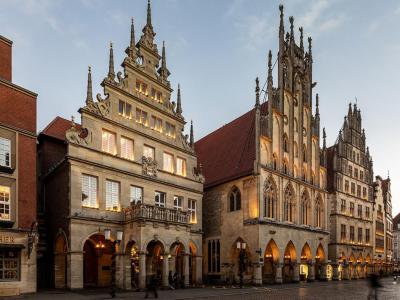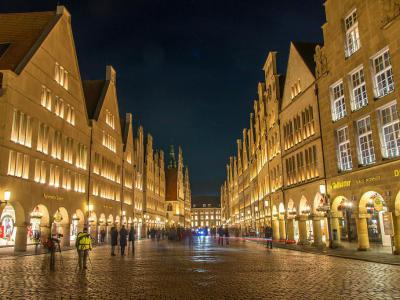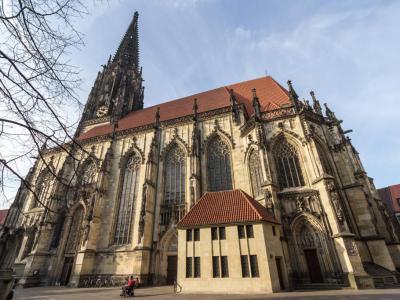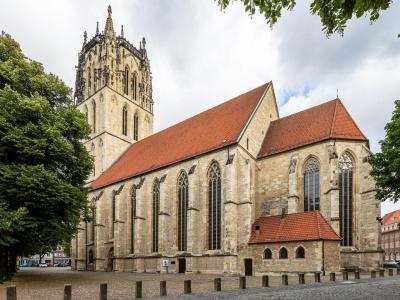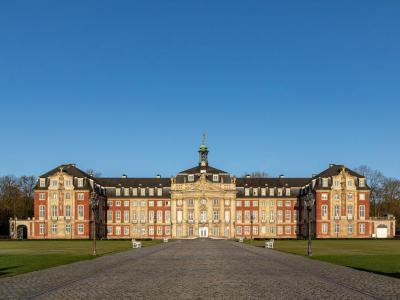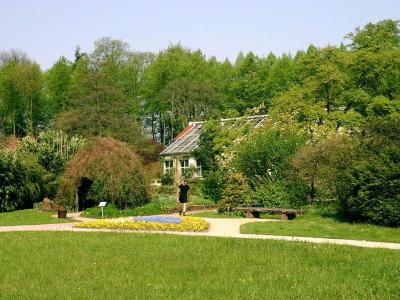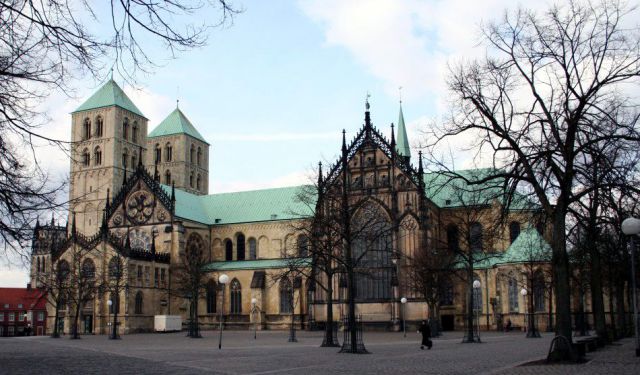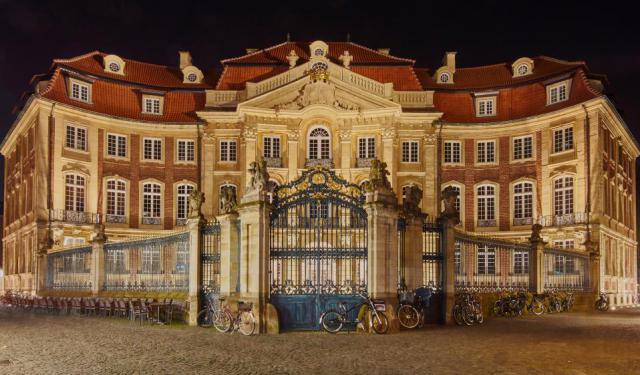
Munster Introduction Walking Tour (Self Guided), Munster
The picturesque city of Münster is in Westphalia, the northwestern region of Germany. It resides along the river Aa and is situated not far from the Netherlands border. Munster's roots date back to A.D. 793, when Ludger, a Frisian missionary, was sent to the region by Charlemagne to evangelize the Saxons and found a monastery. Known as the founder of Münster, Ludger later became the city's first bishop.
Münster became famous as the site where the Peace of Westphalia negotiations occurred in 1648. Two peace treaties were signed, bringing an end to the Thirty Years' War and the Eighty Years' War (the Dutch Revolt). These events took place in the council chamber of the Historical City Hall of Munster, today a must-see landmark and museum. You'll find it along the Principal Market, Münster's main shopping street.
With World War II came heavy bombing and destruction of many of Münster's beautiful churches and buildings. After the war, the buildings were carefully replicated to bring each structure back to its original form. Today, the charming city is a fabulous place for exploration, with plenty of eye-catching Gothic architecture and history. Known by some as the "bicycle capital of Germany," you'll find bikes and bicyclists all over town!
In the heart of the city is Munster Cathedral, a magnificent 13th-century cathedral with Gothic and Romanesque architecture. Another must-see in Münster is St. Lamberti Church, a landmark notable for its stunning neo-Gothic spire. On the spire hang three iron cages which once contained the bodies of three leaders of Munster Rebellion, executed and put on public display in 1536.
Münster is a vibrant university town filled with students that attend the University of Münster. Prince Bishop's Palace in Münster is a stately mansion that was once the residence of the ruling prince-bishop. Today, this palatial structure is the administrative center of the university. Don't miss a visit to the university's beautiful botanical garden, not far from the palace.
You'll love strolling the winding cobbled streets as you explore the historic city of Munster on this self-guided walking tour.
Münster became famous as the site where the Peace of Westphalia negotiations occurred in 1648. Two peace treaties were signed, bringing an end to the Thirty Years' War and the Eighty Years' War (the Dutch Revolt). These events took place in the council chamber of the Historical City Hall of Munster, today a must-see landmark and museum. You'll find it along the Principal Market, Münster's main shopping street.
With World War II came heavy bombing and destruction of many of Münster's beautiful churches and buildings. After the war, the buildings were carefully replicated to bring each structure back to its original form. Today, the charming city is a fabulous place for exploration, with plenty of eye-catching Gothic architecture and history. Known by some as the "bicycle capital of Germany," you'll find bikes and bicyclists all over town!
In the heart of the city is Munster Cathedral, a magnificent 13th-century cathedral with Gothic and Romanesque architecture. Another must-see in Münster is St. Lamberti Church, a landmark notable for its stunning neo-Gothic spire. On the spire hang three iron cages which once contained the bodies of three leaders of Munster Rebellion, executed and put on public display in 1536.
Münster is a vibrant university town filled with students that attend the University of Münster. Prince Bishop's Palace in Münster is a stately mansion that was once the residence of the ruling prince-bishop. Today, this palatial structure is the administrative center of the university. Don't miss a visit to the university's beautiful botanical garden, not far from the palace.
You'll love strolling the winding cobbled streets as you explore the historic city of Munster on this self-guided walking tour.
How it works: Download the app "GPSmyCity: Walks in 1K+ Cities" from Apple App Store or Google Play Store to your mobile phone or tablet. The app turns your mobile device into a personal tour guide and its built-in GPS navigation functions guide you from one tour stop to next. The app works offline, so no data plan is needed when traveling abroad.
Munster Introduction Walking Tour Map
Guide Name: Munster Introduction Walking Tour
Guide Location: Germany » Munster (See other walking tours in Munster)
Guide Type: Self-guided Walking Tour (Sightseeing)
# of Attractions: 9
Tour Duration: 2 Hour(s)
Travel Distance: 2.3 Km or 1.4 Miles
Author: Xena
Sight(s) Featured in This Guide:
Guide Location: Germany » Munster (See other walking tours in Munster)
Guide Type: Self-guided Walking Tour (Sightseeing)
# of Attractions: 9
Tour Duration: 2 Hour(s)
Travel Distance: 2.3 Km or 1.4 Miles
Author: Xena
Sight(s) Featured in This Guide:
- St. Paulus Dom (Munster Cathedral)
- Westphalian State Museum of Art and Cultural History
- Picasso Museum
- Historical City Hall of Münster
- Prinzipalmarkt (Principal Market)
- Lambertikirche (St. Lamberti Church)
- Überwasserkirche (Overwater Church)
- Fürstbischöfliches Schloss Münster (Prince Bishop's Palace in Münster)
- Botanischer Garten Münster (Munster Botanical Garden)
1) St. Paulus Dom (Munster Cathedral) (must see)
In the heart of this German city, you'll find Munster Cathedral, known as St. Paulus Dom (The Cathedral Church of Saint Paul). This Catholic church features mainly Gothic architecture, constructed in the 13th century. There are two large Romanesque-style towers preserved from an earlier cathedral that was located at this site. The towers are topped with copper-covered pyramids.
The church interior features a central nave surrounded by two side aisles. As you enter, you'll be greeted by a sizable statue of St. Christopher, the patron saint of travelers, standing on a pillar on one side of the nave. This sculpture dates from 1627. The Old Choir (Alte Chor) boasts a Baroque-style high altar that sits below round decorative windows. Underneath the Old Choir are tombs of the bishops.
Don't miss the superb astronomical clock, one of the most famous and intriguing features of the cathedral's interior. Built between 1540 and 1542, it has a 24-hour clock face, runs counterclockwise, and displays astronomical information such as the moon's phases and the positions of the planets. There are also three organs inside the church and some marvelous stained-glass windows.
Bombing during World War II caused considerable damage to the cathedral. A rebuilding of the structure to bring it back to its original appearance took place in the decade following the war. An extensive restoration also took place in the 21st century, completed in 2013.
Today, this beautiful cathedral offers regular church services and public tours. In front of Munster Cathedral is Cathedral Square (Domplatz), a vast public square paved in cobblestone bricks. The Weekly Market (Wochenmarkt), a vibrant farmer's market, is held twice weekly (Wednesday and Saturday) in the cathedral square.
The church interior features a central nave surrounded by two side aisles. As you enter, you'll be greeted by a sizable statue of St. Christopher, the patron saint of travelers, standing on a pillar on one side of the nave. This sculpture dates from 1627. The Old Choir (Alte Chor) boasts a Baroque-style high altar that sits below round decorative windows. Underneath the Old Choir are tombs of the bishops.
Don't miss the superb astronomical clock, one of the most famous and intriguing features of the cathedral's interior. Built between 1540 and 1542, it has a 24-hour clock face, runs counterclockwise, and displays astronomical information such as the moon's phases and the positions of the planets. There are also three organs inside the church and some marvelous stained-glass windows.
Bombing during World War II caused considerable damage to the cathedral. A rebuilding of the structure to bring it back to its original appearance took place in the decade following the war. An extensive restoration also took place in the 21st century, completed in 2013.
Today, this beautiful cathedral offers regular church services and public tours. In front of Munster Cathedral is Cathedral Square (Domplatz), a vast public square paved in cobblestone bricks. The Weekly Market (Wochenmarkt), a vibrant farmer's market, is held twice weekly (Wednesday and Saturday) in the cathedral square.
2) Westphalian State Museum of Art and Cultural History (must see)
The Westphalian State Museum of Art and Cultural History hosts a massive collection of paintings, sculptures, drawings, handicrafts, prints, and other art objects. Since 2013, it has been officially called the LWL Museum for Art and Culture (LWL-Museum für Kunst und Kultur). It was founded over 100 years ago and has resided in a new building on Cathedral Square, next to St. Paulus Dom, since 2014.
There are over 350,000 pieces of art in the museum's eclectic collection. The artwork dates from a period that spans 1,000 years, from the Middle Ages to the current day. There are thousands of books in the museum library. The museum offers 51 intriguing exhibition halls to explore.
Museum highlights include a medieval collection with panel paintings, sculptures, reliefs, and stained glass. There are works by old masters from the Renaissance to the Baroque period. A coin collection focuses on Roman coins, regional coins, medals, and paper money. One gallery is devoted to the work of German Expressionist painter August Macke. A gigantic collection of printed portraits by Baron Hans-Dietrich von Diepenbroick-Grueter is included.
In addition to the permanent exhibits, this splendid art museum offers special exhibitions, tours, and workshops. There is a museum shop and an upscale restaurant with huge picture windows offering views of the outdoor patio and lively city street.
There are over 350,000 pieces of art in the museum's eclectic collection. The artwork dates from a period that spans 1,000 years, from the Middle Ages to the current day. There are thousands of books in the museum library. The museum offers 51 intriguing exhibition halls to explore.
Museum highlights include a medieval collection with panel paintings, sculptures, reliefs, and stained glass. There are works by old masters from the Renaissance to the Baroque period. A coin collection focuses on Roman coins, regional coins, medals, and paper money. One gallery is devoted to the work of German Expressionist painter August Macke. A gigantic collection of printed portraits by Baron Hans-Dietrich von Diepenbroick-Grueter is included.
In addition to the permanent exhibits, this splendid art museum offers special exhibitions, tours, and workshops. There is a museum shop and an upscale restaurant with huge picture windows offering views of the outdoor patio and lively city street.
3) Picasso Museum (must see)
The Picasso Museum in Munster (Kunstmuseum Pablo Picasso Münster) is an art museum featuring an immense collection of work by renowned artist Pablo Picasso. Picasso was born in Spain in 1881 and was famous as a painter, sculptor, and printmaker. In 2000, this museum opened to the public — it is the only one devoted to Picasso in Germany.
The museum showcases a comprehensive collection of Picasso's lithographs, linocuts, and prints. It includes almost the entirety of his lithographic body of work. There is also a collection of photographs taken of Picasso. The Picasso Museum is housed in two adjoining historic buildings in the heart of the picturesque city center. The exhibition space covers 600 square meters over two floors.
This museum also boasts several hundred art pieces created by Picasso's friends and fellow artists, including Marc Chagall, Henri Matisse, Georges Braque, and Joan Miró. It regularly hosts temporary special exhibitions devoted to the artwork of Picasso and his contemporaries. A museum shop offers Picasso-related souvenirs and gifts. Those looking for a bite to eat will enjoy the charming little bistro called "Monsieur P."
The museum showcases a comprehensive collection of Picasso's lithographs, linocuts, and prints. It includes almost the entirety of his lithographic body of work. There is also a collection of photographs taken of Picasso. The Picasso Museum is housed in two adjoining historic buildings in the heart of the picturesque city center. The exhibition space covers 600 square meters over two floors.
This museum also boasts several hundred art pieces created by Picasso's friends and fellow artists, including Marc Chagall, Henri Matisse, Georges Braque, and Joan Miró. It regularly hosts temporary special exhibitions devoted to the artwork of Picasso and his contemporaries. A museum shop offers Picasso-related souvenirs and gifts. Those looking for a bite to eat will enjoy the charming little bistro called "Monsieur P."
4) Historical City Hall of Münster (must see)
Situated along Principal Market (Prinzipalmarkt), the city's central marketplace and shopping district is the Historical City Hall of Münster (Historisches Rathaus Münster). The building gained fame as the location used for the peace negotiations in 1648 that ended the Thirty Years' War in Europe and the Eighty Years' War, also known as the Dutch Revolt. The council chamber of this historic town hall is known as the Hall of Peace (Friedenssaal).
The building is estimated to date from the 14th century. Its sandstone facade features a stunning Gothic-style design. The structure's layout splits into three levels as arcade floor, the main floor, and the gable floor. The front boasts a lovely arched colonnade. The building's eye-catching Gothic gable is highly ornate and can't be missed while roaming through Principal Market.
This town hall now operates as a museum in the historical Peace Hall. The council chamber walls where the peace treaties were signed are decorated with ornately carved wood paneling. A small figure of Jesus on the cross is mounted behind the judge's table. There are wall portraits and an elaborate chandelier in the room. Inside a glass display case is the famous 17th-century "Golden Cockerel," a gilded silver wine goblet in the shape of a rooster.
The museum includes historical weapons and suits of armor. You'll find a rather eclectic collection of artifacts on display, including a decoratively engraved fireplace and chimney replica, 16th-century bench seat cushions, a doorkeeper's staff, and a 17th-century woman's slipper. The oddest is a small oak box topped with an actual severed hand, origin unknown!
The building was seriously damaged when it was hit by bombs during World War II and soon underwent a complete restoration. A full reconstruction of its original appearance didn't begin until 1950 and took most of the decade to complete. This significant historical landmark is a must-see during your tour of Munster.
The building is estimated to date from the 14th century. Its sandstone facade features a stunning Gothic-style design. The structure's layout splits into three levels as arcade floor, the main floor, and the gable floor. The front boasts a lovely arched colonnade. The building's eye-catching Gothic gable is highly ornate and can't be missed while roaming through Principal Market.
This town hall now operates as a museum in the historical Peace Hall. The council chamber walls where the peace treaties were signed are decorated with ornately carved wood paneling. A small figure of Jesus on the cross is mounted behind the judge's table. There are wall portraits and an elaborate chandelier in the room. Inside a glass display case is the famous 17th-century "Golden Cockerel," a gilded silver wine goblet in the shape of a rooster.
The museum includes historical weapons and suits of armor. You'll find a rather eclectic collection of artifacts on display, including a decoratively engraved fireplace and chimney replica, 16th-century bench seat cushions, a doorkeeper's staff, and a 17th-century woman's slipper. The oddest is a small oak box topped with an actual severed hand, origin unknown!
The building was seriously damaged when it was hit by bombs during World War II and soon underwent a complete restoration. A full reconstruction of its original appearance didn't begin until 1950 and took most of the decade to complete. This significant historical landmark is a must-see during your tour of Munster.
5) Prinzipalmarkt (Principal Market) (must see)
In the heart of Munster, you'll find the picturesque shopping street Principal Market (Prinzipalmarkt). This historic marketplace is lined with beautiful gabled houses and arcaded walkways. During World War II, this area was mostly destroyed and was reconstructed close to its original form in the decade after the war.
As you stroll along this charming cobbled roadway, you'll find a lively shopping district with restaurants and plenty of upscale shops. At the north end of Principal Market is the St. Lamberti Church (Lambertikirche), a stunning old church with a tall neo-Gothic steeple. Along the route, you'll also come across the Historical City Hall of Münster, a splendid historic building with beautiful Gothic architecture.
Enjoy the vibrant atmosphere as you explore and window shop in Munster's Principal Market. The street plays a central role in city activities, hosting festivals and cultural events. Be sure to look at the intriguing architecture and ornate designs of the gabled buildings, each unique. You'll love spending time at this charming location during your tour of Munster.
As you stroll along this charming cobbled roadway, you'll find a lively shopping district with restaurants and plenty of upscale shops. At the north end of Principal Market is the St. Lamberti Church (Lambertikirche), a stunning old church with a tall neo-Gothic steeple. Along the route, you'll also come across the Historical City Hall of Münster, a splendid historic building with beautiful Gothic architecture.
Enjoy the vibrant atmosphere as you explore and window shop in Munster's Principal Market. The street plays a central role in city activities, hosting festivals and cultural events. Be sure to look at the intriguing architecture and ornate designs of the gabled buildings, each unique. You'll love spending time at this charming location during your tour of Munster.
6) Lambertikirche (St. Lamberti Church) (must see)
St. Lamberti Church (Lambertikirche) is a magnificent Roman Catholic church in Munster's city center, next to Principal Market (Prinzipalmarkt). Construction of the current building began in 1375, with work continuing in stages throughout the 15th century.
This landmark parish church features Gothic architecture and a stunning church tower. The central nave stands below a soaring vaulted ceiling. There are beautiful stained-glass windows behind the high altar. Some very ornamental religious art pieces, figures, and sculptures can be seen around the church's interior and exterior.
Above the clock on the neo-Gothic church spire are three iron cages, a reminder of a dark part of this church's history. In 1536, three rebellion leaders were tortured and killed, their mutilated bodies placed on public display inside the cages — where they remained for 50 years!
The church holds regular worship services. They have music groups and community choirs. Music plays a big part in the church's operation. There are two pipe organs — a large suspended organ in the main hall and a smaller choir organ. There are also eight magnificent bells, several dating back over five centuries, in the belfry. Above the belfry is a 16th-century fire bell. The bells still ring for church services today.
This landmark parish church features Gothic architecture and a stunning church tower. The central nave stands below a soaring vaulted ceiling. There are beautiful stained-glass windows behind the high altar. Some very ornamental religious art pieces, figures, and sculptures can be seen around the church's interior and exterior.
Above the clock on the neo-Gothic church spire are three iron cages, a reminder of a dark part of this church's history. In 1536, three rebellion leaders were tortured and killed, their mutilated bodies placed on public display inside the cages — where they remained for 50 years!
The church holds regular worship services. They have music groups and community choirs. Music plays a big part in the church's operation. There are two pipe organs — a large suspended organ in the main hall and a smaller choir organ. There are also eight magnificent bells, several dating back over five centuries, in the belfry. Above the belfry is a 16th-century fire bell. The bells still ring for church services today.
7) Überwasserkirche (Overwater Church)
Overwater Church (Überwasserkirche) is a beautiful Gothic hall church from 1340. The name of the church translates to "above water" (or "over water"), named for its location across the waters of the Münstersche Aa, a scenic river in Munster. The church is also known as the Church of Our Dear Lady (Liebfrauenkirche).
This splendid parish church features stunning Gothic architecture and a tall steeple. The soaring interior includes three naves and glorious, light-filled stained-glass windows behind the main altar. There is a large organ at the rear of the central nave and a smaller second organ in the choir room. Look for the apostles of Jesus that decorate the steeple portal. A carved Madonna and child greet you as you enter.
The bombings of World War II left this church severely damaged. A major restoration took place, completed in 1968. In 2016, another renovation required the church to close for most of that year. Today, this medieval church holds regular worship services, social activities, and events. It's a lovely place you'll want to check out during your tour around Munster.
This splendid parish church features stunning Gothic architecture and a tall steeple. The soaring interior includes three naves and glorious, light-filled stained-glass windows behind the main altar. There is a large organ at the rear of the central nave and a smaller second organ in the choir room. Look for the apostles of Jesus that decorate the steeple portal. A carved Madonna and child greet you as you enter.
The bombings of World War II left this church severely damaged. A major restoration took place, completed in 1968. In 2016, another renovation required the church to close for most of that year. Today, this medieval church holds regular worship services, social activities, and events. It's a lovely place you'll want to check out during your tour around Munster.
8) Fürstbischöfliches Schloss Münster (Prince Bishop's Palace in Münster)
Prince Bishop's Palace in Münster (Fürstbischöfliches Schloss Münster) is a grand 18th-century mansion that was once the residence of the prince-bishop of Munster. This magnificent palace was built for 20 years between 1767 and 1787. It boasts Baroque-style architecture.
Johann Conrad Schlaun, a noteworthy German Baroque architect, designed the building. The structure, constructed of red brick and sandstone, includes four stories and several large wings. The immense cobblestone square next to the palace is often used to host events. On the roof, 18 bells chime out songs and ring every quarter of an hour to mark the time.
With heavy bombing taking place during World War II, the palace was severely damaged and required extensive reconstruction. Today, this building is part of the University of Münster and is located near the University's botanical garden. This eye-catching structure is a must-see on your exploration of Munster — and don't miss a stroll through the beautiful botanical garden while you're there.
Johann Conrad Schlaun, a noteworthy German Baroque architect, designed the building. The structure, constructed of red brick and sandstone, includes four stories and several large wings. The immense cobblestone square next to the palace is often used to host events. On the roof, 18 bells chime out songs and ring every quarter of an hour to mark the time.
With heavy bombing taking place during World War II, the palace was severely damaged and required extensive reconstruction. Today, this building is part of the University of Münster and is located near the University's botanical garden. This eye-catching structure is a must-see on your exploration of Munster — and don't miss a stroll through the beautiful botanical garden while you're there.
9) Botanischer Garten Münster (Munster Botanical Garden)
Munster Botanical Garden (Botanischer Garten Münster) is a spectacular park dating from the early years of the 19th century. It is part of the University of Munster and is located near Prince Bishop's Palace (Fürstbischöfliches Schloss Münster), once a residence of Munster's prince-bishop. Explore the pathways that wind around the garden as you view an impressive variety of plants, flowers, and trees.
Exploring the Botanical Garten, you will find themed gardens, ten greenhouses, and thousands of different plant species. Collections include geographical flora from around the world, a cottage garden with edible plants, a medicinal plant garden, native flora, and a sensory garden. Don't miss the collection of succulents, tropical plants, and the Arboretum.
In addition to being open to the public, the botanical garden serves as a scientific research and teaching facility. Take a stroll around this lovely and educational botanical garden, where you can learn about plants while enjoying this peaceful, beautiful place. Admission to the Munster Botanical Garden is free.
Exploring the Botanical Garten, you will find themed gardens, ten greenhouses, and thousands of different plant species. Collections include geographical flora from around the world, a cottage garden with edible plants, a medicinal plant garden, native flora, and a sensory garden. Don't miss the collection of succulents, tropical plants, and the Arboretum.
In addition to being open to the public, the botanical garden serves as a scientific research and teaching facility. Take a stroll around this lovely and educational botanical garden, where you can learn about plants while enjoying this peaceful, beautiful place. Admission to the Munster Botanical Garden is free.
Walking Tours in Munster, Germany
Create Your Own Walk in Munster
Creating your own self-guided walk in Munster is easy and fun. Choose the city attractions that you want to see and a walk route map will be created just for you. You can even set your hotel as the start point of the walk.
Munster's Religious Buildings Tour
Munster, a German city steeped in history and religious significance, boasts a myriad of places of worship that have withstood the test of time. Concentrated in the Old Town, they showcase the diversity of styles fit to impress anyone interested in religious architecture.
One of the most notable landmarks is the Munster Cathedral. Also known as Saint Paulus Dom, it has retained much of its... view more
Tour Duration: 2 Hour(s)
Travel Distance: 2.5 Km or 1.6 Miles
One of the most notable landmarks is the Munster Cathedral. Also known as Saint Paulus Dom, it has retained much of its... view more
Tour Duration: 2 Hour(s)
Travel Distance: 2.5 Km or 1.6 Miles
Munster's Historical Buildings Walking Tour
The centuries-long history of Munster, set in stone, is still very much alive. The carefully restored ancient homes, churches, and other – sometimes peculiar – pieces of architecture, abounding the city, “tell” the tales of its past rather eloquently, all the while setting a stage that makes every visit to Munster an exciting experience.
The reconstruction of the local Old Town,... view more
Tour Duration: 2 Hour(s)
Travel Distance: 2.8 Km or 1.7 Miles
The reconstruction of the local Old Town,... view more
Tour Duration: 2 Hour(s)
Travel Distance: 2.8 Km or 1.7 Miles
The Most Popular Cities
/ view all
